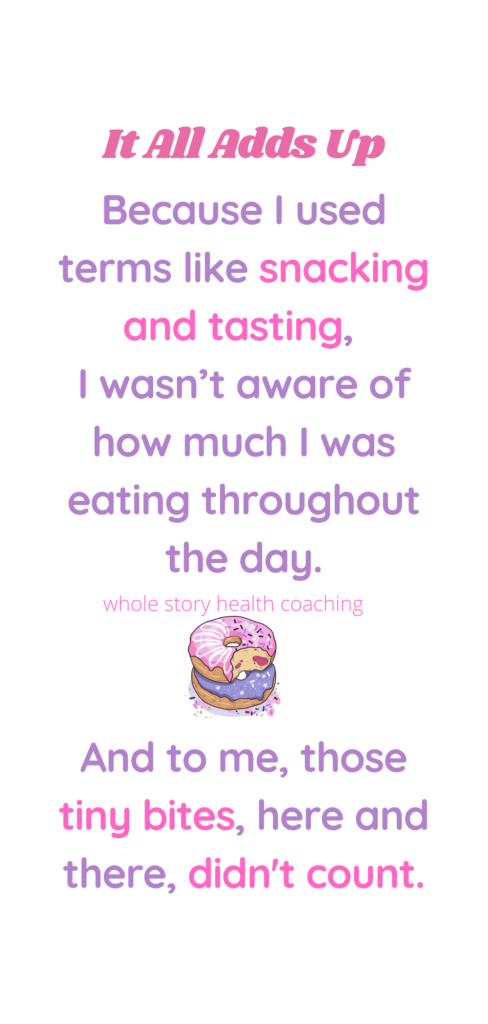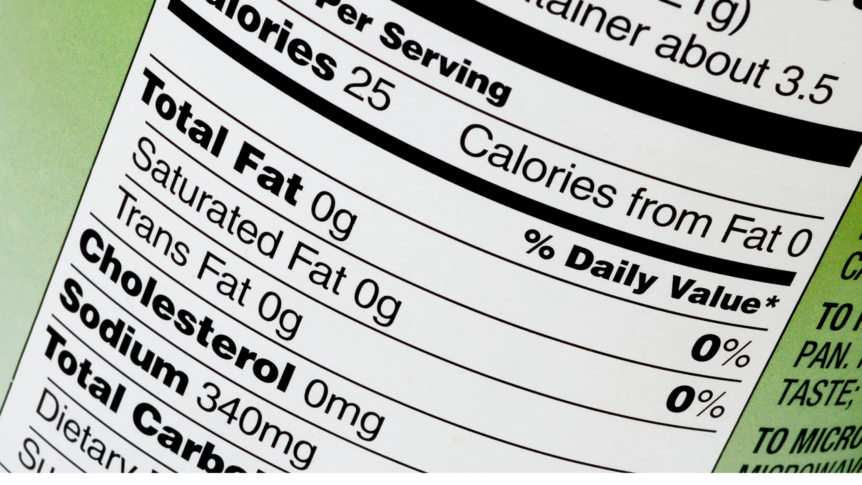Navigating our journey with food takes skill. Those of us who have struggled through the maze of weight gain, loss, and regain know just how hard it can be.
And while it may be tempting to turn to quick weight loss plans, the reality is that the answers lie within us.
For me, working out my own process was critical. What worked for others simply did not work for me. There was quite a bit of inner work that I had to do to break free from my yo-yo dieting and emotional rollercoaster lifestyle.
I covered a few of those interventions in Part 1. We discussed how to:
- Develop a healthy relationship with the scale
- Observe yourself without judgment
- Ditch the diet mindset
Below are some other areas I learned to work through and pay close attention to—with a lot of trial and error.
Each can be personalized to fit most people.
1. Learn to Monitor Your Food Intake
One question/concern that I have heard repeatedly over the years is, “Why am I not losing weight? I eat healthy.”
My response is always the same,”Do you measure your food?” The answer is usually, “No.”
Here’s the thing…very often, people underestimate how much they are actually consuming and overestimate how many calories they are burning.
To effectively gauge what we are actually eating requires that we find some way to measure and monitor our food and calorie intake.
2. Understand: There is No One-Size-Fits-All Approach
We are all unique with a variety of needs and goals.
In addition to these differences, as we make changes and progress, the way we track our food may change over time. So, we will need to consider several different approaches to monitor what we eat and drink.

3. Eat Mindfully
In the initial stages of my weight loss journey, it was enough to just become aware that I was eating at all. That was huge.
Since I did a lot of mindless snacking , sometimes, I didn’t even remember eating.
This type of monitoring was about becoming mindful.
Next, I came to understand how my views of eating were also sabotaging me (and keeping me mindless).
Because I used terms like snacking and tasting, I didn’t realize how much I was eating throughout the day. Afterall, I wasn’t eating meals. And to me, those tiny bites, here and there, didn’t count.
Lessening my denial and increasing my awareness were major and beneficial first steps.
4. Serving Size Matters
As my levels of awareness increased, I started to weigh more of my food, which gave me a much better assessment of what I was actually consuming.
I was shocked and horrified to find out what serving sizes really looked like. What I thought was a normal bowl of cereal, was closer to three servings.
I quickly found out that serving sizes didn’t come close to satisfying my appetite.
And that I couldn’t accurately gauge a serving size with my eyes.
Weighing the Options
Because I had previously struggled with disordered eating and being obsessive about my eating habits, I had to be careful going down this road.
In fact, when a friend or client has a history of disordered eating, I never recommend weighing food. It can become a dangerous and paralyzing preoccupation when overused.
Using the weight loss app, My Fitness Pal, was eye-opening, to say the least.
I remember trying to figure out how to log a single french fry or a spoonful of macaroni and cheese. Because I didn’t want to have to weigh every single thing, I just didn’t eat them.
That’s when I realized that my eating habits were on autopilot.
My weight gain was coming from the little things that I was blowing off, not the things I was actually paying attention to.
How to Measure Your Food
Though there are many different ways to measure our food, for now, let’s focus on these four:
- Eating less (baby steps)
- Eyeballing
- Measuring cups
- Hands
- Food scales
These common methods may be used alone or in combination. Each serves a purpose, depending on where we are in our journey and where we want to go.
Eating Less
This is just what it sounds like but still differs from conventional advice. For example, if your typical meal consists of a medium Domino’s pizza (which mine used to), eat one less slice.
If you always get a Starbucks Trenta or Venti (these were my favorite sizes), move down a level.
This method is about taking baby steps and not making drastic, sweeping, unsustainable changes.
We still get to enjoy our favorites, while gradually adjusting our appetites and improving our self-awareness and self-control.
It works well when there is quite a bit of weight to lose—especially when applied to each meal and snack.
We also get the opportunity to celebrate ourselves when we accomplish these small victories.
Honoring our efforts motivates us to continue and expand our new behaviors.
Tip: As you move toward eating less, start to pay attention to when you start to feel full. Challenge yourself to stop at that point. It may be difficult at first, but it does get easier.
Eyeballing
I’ll be honest, this is one of my least favorite methods, but when you’re just starting out with a significant amount of weight to lose, it can be of great help.
Like I mentioned earlier, we each have our own needs and goals.
Eyeballing is just looking and estimating how much we are eating. Again, when there is a significant amount of weight to lose, this type of method is easy and effective.
Although we won’t know the serving sizes or calories, we can see that our plate, bowl, or cup aren’t as full— or that we have simply chosen smaller ones.
Measuring Cups
Measuring with cups is a bit more accurate.
An important point to remember is the cup size and the serving size in grams rarely match.
This isn’t so important in the early stages of our weight loss journeys, but keep in mind that extra food means extra calories. And they will add up—eventually.
Hands
This is a method that I learned while earning my nutrition coaching certification.
And, it’s another great tool for those getting started with portion control. We take our hands everywhere. Plus, over time, we come to recognize a palm-sized portion of meat or a thumb-sized piece of butter.
This method may not work as well for people who want a more accurate approach or want to fine tune their weight loss efforts.
For more detailed information, click the link and determine if it is something that is right for you.
Food scales
My personal favorite. I enjoyed what I felt was precision. Although, counting calories perfectly isn’t possible, depending on what result we are seeking, it offers a closer estimate than other methods.
I no longer weigh my food as much. After 5 years , I can eyeball what works for me. But, just in case, I make sure to keep a quality scale nearby.
The key word here is quality. Do your research. Read the reviews and pay special attention to the low stars. They often offer a view of problems that are consistent and unique to a certain model or brand.
With the exception of using my hands ( I didn’t know about it), I have used each of these approaches. However, as I progressed and my goals changed, so did my chosen combination of tools.
5 Tips for Monitoring Your Food Intake
- Ultimately, I settled on the food scale. You may not. So tip number one is to figure out and focus on what works for you.
- Recognize that even bites of food contain calories—that can add up quickly. Becoming aware of these itty bitty suspects is key.
- Jot down when you are eating and if there is an associated trigger (mood changes, boredom)…also note which foods you are choosing.
- Download the PDF to become aware of environmental factors like fast food restaurants on your driving route, trigger foods in your home, etc.
- Be honest with yourself. Sometimes I hid my eating habits to avoid feeling shame. Unfortunately, hiding from others won’t hide our behaviors from the scale.
Putting It All Together
Learning how to become self-aware and manage our food intake is a process. Although there are apps, plans, and programs, what we really need is to take a look at what is fueling our choices.
Going within, understanding our “why” (which may even be medical), and addressing the real factors are what will lead us to success…not putting bandaid after bandaid on a hemorrhaging wound.


